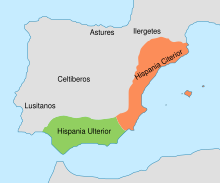| Battle of Bergium | |||||||
|---|---|---|---|---|---|---|---|
| Part of Roman conquest of the Iberian Peninsula Iberian revolt (197-195 BC) | |||||||
 Hispania around the year 197 BC. | |||||||
| |||||||
| Belligerents | |||||||
|
| Hispanic rebels | ||||||
| Commanders and leaders | |||||||
|
| |||||||
| Strength | |||||||
| 20,000 men[1] | |||||||
The battle of Rhode was one of the battles of the 197 BC revolt of the Iberian peoples against Roman domination in the 2nd century BC.
Background
editThe victory of the Republic of Rome over Carthage in the Second Punic War left Hispania in Roman hands. The transformation of the territory into a province caused important administrative and fiscal changes,[2] and the imposition of the stipendium was not accepted by the local tribes that still enjoyed a certain political structure and capacity of reaction,[3] so that in 197 B.C., just after the Second Macedonian War, a great revolt broke out in the entire conquered area of Hispania because of the Republican plundering.
Numerous local chiefs rebelled in Hispania Ulterior and the republic sent Gaius Sempronius Tuditanus to Hispania Citerior and Marcus Helvius Blasion to Hispania Ulterior.[4] Gaius Sempronius Tuditanus died of battle wounds in Hispania Citerior before the end of 197 BC,[5] but Quintus Minucius Thermus defeated the insurgents at the battle of Turda in 196 BC.[6] Quintus Fabius Buteon and Marcus Helvius Blasion defeated the Celtiberians at the battle of Iliturgi.[6] The Roman Senate declared Hispania Citerior a consular province[6] and the consul Marcus Porcius Cato the Elder went from the port of Luna, bordering the Gulf of Leon with Publius Manlius as assistant, leaving the Ulterior to Appius Claudius Nero with smaller troops.
The battle
editMarcus Porcius Cato the Elder, who had two legions, eight thousand infantry, fifteen thousand allies and 800 horsemen for the consular army and two thousand infantry and two hundred horsemen for each of the praetors,[1] landed at Rhode,[4] putting down the resistance of the Hispanic garrison located on the Puig Rom[7] or acropolis of Rhode.[5]
Consequences
editThe Roman army landed in Emporion, and Cato the Elder had the ships return to Massalia with the merchants to force his army to fight. Cato starts in Emporion, an almost island surrounded by marshes, a hard training of the troops. The rebel army besieging Emporion, of about 40,000 men, was also defeated by Cato in the battle of Emporion. Marcus Porcius Cato the Elder succeeded in a few days in pacifying the entire coastal strip and subduing the Lacetani, Suessetani and Ausetani,[8] and defeating the Lacetani and Bergistani,[1] who were still resisting in their city of Bergium.[8][9] The Romans ordered[4] the Iberians to sink the walls on pain of being reduced to slavery, and so did the oppida around the Ebro.
See more
editReferences
edit- ^ a b c Martínez Gázquez, José (1992). La campaña de Catón en Hispania (in Spanish) (2nd ed.). Publicacions i Edicions UB. ISBN 9788478759804.
- ^ Arrayás Morales, Isaías (2005). Morfología histórica del territorio de Tarraco (ss. III- .C.) (in Spanish) (1st ed.). Publicacions i Edicions UB. p. 40. ISBN 8447530078.
- ^ Hernández Cardona, Francesc Xavier (2001). Dalmau, Rafael (ed.). Història militar de Catalunya, vol. I, dels íbers las carolingis (in Catalan) (1st ed.). p. 134. ISBN 84-232-0639-4.
- ^ a b c Apiano. Ibèria (in Catalan). pp. 39–41.
- ^ a b Nolla, Josep M. "La campaya de M. P. Cató a empúries el 195 a.C. Algunas consideracions". Revista Girona (in Catalan).
- ^ a b c Brennan, Corey Loog (2000). The praetorship in the Roman Republic Vol. I (1st ed.). Oxford University Press. p. 166. ISBN 0-19-511459-0.
- ^ Maluquer de Motes i Nicolau, Joan. La ciutat grega mes antiga de Catalunya (in Catalan).
- ^ a b Rovira i Virgili, Antoni (1920). Història Nacional de Catalunya, volum I (in Catalan). Edicions Pàtria. p. 55.
- ^ Ramon i Arrufat, Antoni. Història, vol. IX: llibres XVIII-XXI Per Polibi (in Catalan).
Further reading
edit- Astin, A. E. (1978), Cato the Censor, Oxford: Clarendon Press
- Chassignet, M. (1986), Caton: Les Origines. Fragments (in French), Paris: Colección Budé, Les Belles Lettres
- Dalby, Andrew (1998), Cato: On Farming, Totnes: Prospect Books, ISBN 0907325807
- Malcovati, H. (1955), Oratorum romanorum fragmenta liberae rei publicae, Turin: Paravia
- Vidal, Gerardo (2002–2003), Catón el viejo y la primera asimilación romana de la cultura griega (in Spanish)
{{citation}}: CS1 maint: date format (link) - Rodríguez Martínez, Felipe (2005), Misterios de las religiones: Catón el Viejo, el defensor de Roma (in Spanish), Clarendon Press
- Bonner, Stanley F. (1984), La educación en la antigua Roma: desde Catón el Viejo a Plinio el joven (in Spanish), Barcelona: Herder
- Corti, Eugenio (2008). Catón el Viejo (in Spanish). Ediciones Sígueme. ISBN 978-84-301-1678-2.
External links
edit
<nowiki>